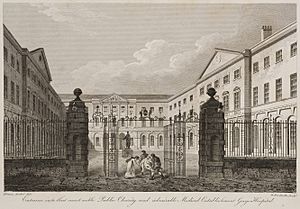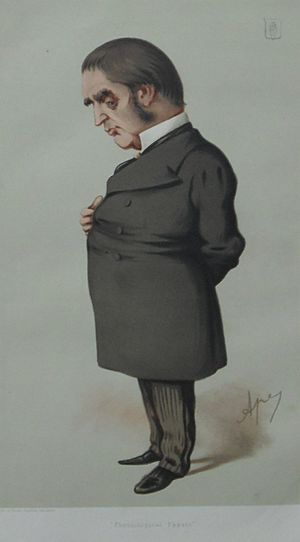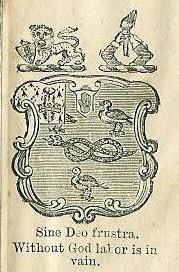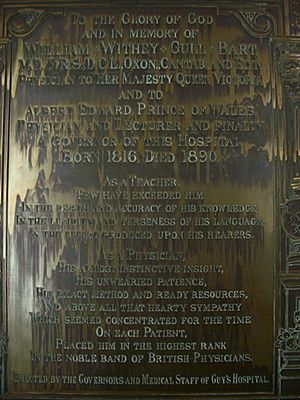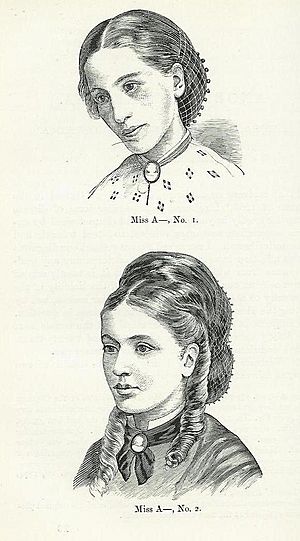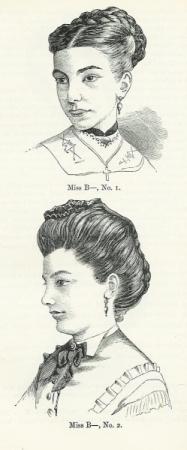William Gull facts for kids
Quick facts for kids
Sir William Withey Gull, Bt
|
|
|---|---|
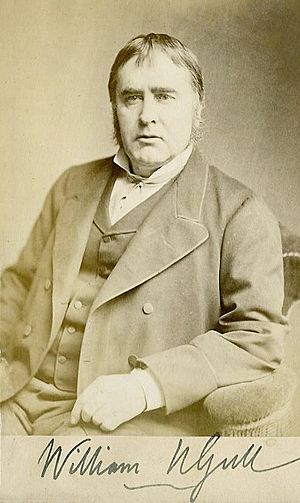
Gull around 1860
|
|
| Born | 31 December 1816 Colchester, Essex, England
|
| Died | 29 January 1890 (aged 73) 74 Brook Street, London, England
|
| Known for | Naming of anorexia nervosa, discovery of Gull–Sutton syndrome, seminal research into paraplegia and myxoedema |
| Spouse(s) |
Susan Ann Lacy
(m. 1848) |
| Children | Cameron Gull |
| Scientific career | |
| Fields | Medicine |
| Institutions | Guy's Hospital, London |
Sir William Withey Gull (born December 31, 1816 – died January 29, 1890) was an important English doctor. He came from a humble family but became a very successful private doctor. He also served as a leader at Guy's Hospital in London.
In 1871, he successfully treated the Prince of Wales (who later became King Edward VII) when he was very sick with typhoid fever. Because of this, Queen Victoria made him a Baronet and one of her personal doctors.
Gull made big contributions to medical science. He helped us understand diseases like myxoedema, Bright's disease, and paraplegia. He was also the first to name the eating disorder anorexia nervosa.
Some conspiracy theories from the 1970s suggested that Gull knew who Jack the Ripper was, or even that he was the murderer himself. However, experts have said this is very unlikely. Gull was 71 years old and in poor health when the murders happened. This theory has mostly been used in movies and graphic novels, like Jack the Ripper (1988) and From Hell (2001).
Contents
Early Life and Education
William Withey Gull was born on December 31, 1816, in Colchester, England. His father, John Gull, owned barges and worked at a wharf. William was the youngest of eight children.
When William was about four, his family moved to Thorpe-le-Soken, Essex. His father died when William was ten. His mother, Elizabeth Gull, then raised her children with very little money. She taught them to do everything well. William often said his mother gave him his real education.
As a boy, William went to local schools. He started studying Latin when he was fifteen. Later, he became a student-teacher at a school in Lewes, Sussex. There, he studied and taught Latin and Greek. He also became interested in plants, which became a lifelong hobby.
After two years, William wanted to try other careers, even working at sea. But a local church leader helped him continue his studies. William also spent time collecting and studying wildlife specimens. This sparked his interest in biological research, which led him to want to study medicine.
Starting a Medical Career
A relative of the local church leader, Benjamin Harrison, was a leader at Guy's Hospital. He was impressed by William and invited him to study there. In September 1837, just before he turned twenty-one, Gull began his medical training at Guy's Hospital.
Students usually studied at the hospital as "apprentices." Gull was given two rooms at the hospital and £50 a year. He worked very hard, trying to win every prize he could. He won them all!
While studying medicine, he also continued his education in Greek, Latin, and Mathematics. In 1838, he enrolled at the new University of London. In 1841, he earned his M.B. degree and received honors in several medical subjects.
Professional Achievements
In 1842, Gull became a teacher of materia medica (the study of medicines) at Guy's Hospital. He was given a small house and a salary. In 1843, he became a lecturer on Natural Philosophy. He also helped care for patients at the hospital. He was even in charge of the wards for people with mental illness. Thanks to him, these patients were soon treated elsewhere, and those wards were used for other purposes.
Gull spent a lot of time in the hospital wards, day and night. This gave him much experience. In 1846, he earned his M.D. degree from the University of London, which was the highest medical honor at the time. He won a gold medal for it.
From 1846 to 1856, Gull taught Physiology and Comparative Anatomy at Guy's. In 1847, he was elected Fullerian Professor of Physiology at the Royal Institution of Great Britain. He held this post for two years and became good friends with Michael Faraday, a famous scientist. Gull also became a Fellow of the Royal College of Physicians in 1848. He received many other honors throughout his career.
Family Life
On May 18, 1848, Gull married Susan Ann Lacy. They had three children. Their daughter, Caroline Cameron Gull, was born in 1851. She later married Theodore Dyke Acland, who was also a doctor.
Their son, Cameron Gull, died as a baby. Their other son, William Cameron Gull, was born in 1860. He later became the 2nd Baronet and a Member of Parliament (MP).
Doctor to the Royal Family
In 1871, Sir William Gull was the personal doctor to the Prince of Wales. He took charge of the Prince's treatment when he became very ill with typhoid fever.
The Prince of Wales first showed signs of illness on November 13, 1871. His condition was serious for many days. Doctors issued daily updates on his health. One newspaper, The Times, praised Gull's tireless care:
'Dr. Gull had endless energy and never stopped watching over the Prince. His care was so gentle and detailed that he seemed to do the jobs of a doctor, nurse, and helper all at once. He would talk softly to the sick Prince, helping him take tiny bits of food needed for strength. He would lift the Prince, wash him, and always watch his face, heart, and pulse for any change. Sometimes he spent twelve or fourteen hours by the bedside. And after these long hours, he would kindly comfort the Prince's mother, giving hope without promising too much.'
After the Prince recovered, a special thanksgiving service was held. On February 8, 1872, William Gull was made the 1st Baronet of Brook Street. This was a special honor from the Queen.
His family's coat of arms (a special symbol) was created. It included a serpent, three seagulls, and a special feather from the Prince of Wales's symbol. The family motto was Sine Deo Frustra, which means "Without God, Labour Is In Vain."
Sir William Gull was then appointed as a Physician-in-Ordinary to Queen Victoria. This was mostly an honorary title, meaning it was a great honor, but he didn't often see the Queen himself.
Supporting Women in Medicine
In the late 1800s, women were not encouraged to become doctors in Britain. Sir William Gull was at first against it. But he later changed his mind. He spoke out against this unfairness and worked to help women who wanted to be doctors.
In 1886, he led a meeting to create a medical scholarship for women. This was called the Helen Prideaux Memorial Fund. It was named after Frances Helen Prideaux, a talented medical student who had died. Gull said her academic success proved that women could be excellent doctors. He hoped the scholarship would help change attitudes and give women more recognition in medicine.
The fund raised money, and by the mid-1890s, it offered a prize to women graduates of the London School of Medicine for Women. This prize helped them continue their studies.
Later Years and Passing
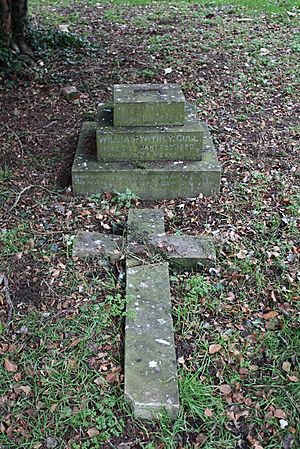
In 1887, Sir William Gull had his first stroke. This caused weakness on one side of his body and made it hard for him to speak. He recovered after a few weeks but knew his health was in danger. He said, "One arrow had missed its mark, but there are more in the quiver."
Over the next two years, he had several more strokes. The final one happened at his home in London on January 27, 1890. He died two days later.
The Times newspaper reported his death, noting how many people came to ask about his health. Even the Prince of Wales was kept informed. The American author Mark Twain wrote in his diary that Gull had "literally cheated Death" when he saved the Prince of Wales.
Sir William Gull was buried on February 3, 1890, next to his parents in Thorpe-le-Soken. A special train carried people from London to his funeral. His tombstone has his favorite Bible quote: "What doth the Lord require of thee, but to do justly, and to love mercy and to walk humbly with thy God?"
A bronze plaque was placed at Guy's Hospital Chapel to remember him. It praised his deep knowledge, clear teaching, and caring nature as a doctor.
Sir William Gull left a large amount of money when he died, about £344,000. This was a huge sum back then. He left money to his wife, children, and staff.
Medical Discoveries
Understanding Anorexia Nervosa
Sir William Gull was the first to use the term "anorexia nervosa" in 1873.
In 1868, he spoke about a "peculiar form of disease" mostly seen in young women. It caused them to become extremely thin. He noticed that the cause was unknown, but it often affected young women between 16 and 23. He first called it Apepsia hysterica, then Anorexia hysterica, and finally Anorexia nervosa.
In 1873, Gull published his important work on Anorexia Nervosa. He described three cases in detail. In 1887, he wrote about another case, Miss K.
Miss A was 17 when she saw Gull in 1866. She had lost a lot of weight and weighed only 82 pounds. She refused most food. Gull noticed she was often restless and active, even though she was so thin. He tried different medicines and diets. She slowly recovered and gained weight. Gull noted that as she recovered, she looked much younger.
Miss B was 18 when she saw Gull in 1868. Her family thought she had tuberculosis. Gull noticed she was extremely thin and also very restless, like Miss A. He treated her until 1872, and she also made a full recovery. Gull believed his medical treatments probably didn't help as much as good nursing and diet.
Miss K was 14 when she saw Gull in 1887. She had stopped eating almost everything except tea or coffee. Gull noted she had no other physical illnesses. Her pulse and temperature were low. She weighed only 63 pounds. Gull arranged for a nurse to supervise her diet. She recovered well after six weeks.
Gull saw at least one patient die from anorexia nervosa. He found that a slow pulse and breathing were common in all cases. He suggested using external heat as a treatment. He also believed that patients' wishes about food should not be followed, especially early on. He learned that giving in to patients' desires could be dangerous.
Gull–Sutton Syndrome (Chronic Bright's Disease)
In 1872, Sir William Gull and Henry G. Sutton presented a paper about chronic Bright's Disease. This disease affects the kidneys. Before their work, doctors thought the kidney was always the first organ to be affected.
Gull and Sutton showed that this was not always true. They found that the disease could start in other organs. The kidney problems were often just one part of a wider illness affecting the whole body. They concluded that changes in the arteries and tiny blood vessels were the main cause of this condition. This meant the disease could show up differently in different people, depending on which organs were most affected.
Myxoedema
In 1873, Gull also presented a paper showing that myxoedema is caused by a problem with the thyroid gland. This gland is in the neck and makes hormones.
Gull described a patient, Miss B, who became sluggish and gained weight. Her face changed from oval to round, her tongue became thick, and her voice was guttural. Her mind became calm and indifferent, but her intelligence was fine. Her skin became smooth and fine, with a unique rose-purple color on her cheeks. Gull noted that in these cases, the thyroid gland was not enlarged.
A few years later, in 1888, this condition was officially named myxoedema.
Spinal Cord and Paraplegia
Paraplegia is a condition where a person cannot move the lower part of their body, usually due to a spinal cord injury. Gull had a long-standing interest in this.
He divided paraplegia into three types:
- Spinal: Caused by damage to the spinal cord itself.
- Peripheral: When many parts of the nervous system fail at once.
- Encephalic: Partial paralysis caused by a problem in the brain.
Gull's main work on paraplegia was published between 1856 and 1858. He helped doctors understand paraplegia better, even with the limited knowledge of the spinal cord at the time. He studied 32 cases, including autopsies (examinations after death) in 29 of them. This helped him connect the symptoms to what was happening inside the body.
He noted that it was hard to find the exact cause of paralysis in some cases. He described different types of spinal cord damage. He also observed that pain around the waist often meant the membranes covering the spinal cord were involved. He found that bladder infections could lead to paralysis of the legs. He also studied cases where tumors or injuries to the spine caused paralysis.
Famous Sayings
- "Fools and savages explain; wise men investigate."
- "Never forget that it is not a pneumonia, but a pneumonic man who is your patient. Not a typhoid fever, but a typhoid man." (This means doctors should treat the whole person, not just the disease.)
- "If facts be nature's words, our words should be true sign of nature's facts. A word rightly imposed is a landmark indicating so much recovered from the region of ignorance."
Jack the Ripper Theories
Sir William Gull is often mentioned in theories and fictional stories about the "Jack the Ripper" murders in 1888. These theories usually involve the Royal Family and the Freemasons.
Gull in Popular Culture
- In the 1979 film Murder by Decree, a character based on Gull is shown as the murderer.
- In the 1988 TV series Jack the Ripper, Gull is played by Ray McAnally and is shown as the killer.
- The graphic novel From Hell (1991-1996) by Alan Moore and Eddie Campbell also shows Gull as the murderer. Eddie Campbell said he liked to think of their William Gull as a fictional character who just happened to share a name with a real person.
- In the 2001 film based on From Hell, Sir William Gull is played by Sir Ian Holm.
- Gull appears as a character in the 2012 novel The Vorrh, where his work on anorexia is mixed into a fantasy story.


